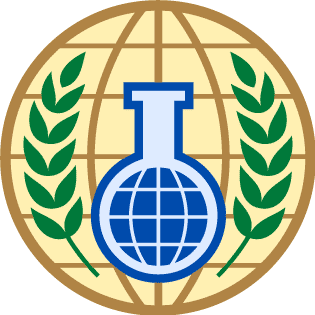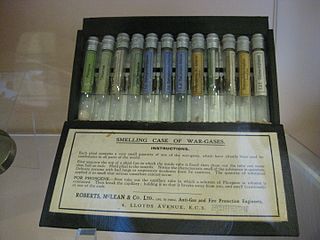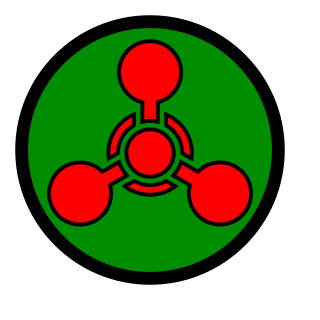
The Organisation for the Prohibition of Chemical Weapons (OPCW) is an intergovernmental organisation and the implementing body for the Chemical Weapons Convention (CWC), which entered into force on 29 April 1997. The OPCW, with its 193 member states, has its seat in The Hague, Netherlands; it oversees the global endeavour for the permanent and verifiable elimination of chemical weapons.

Phosgene is the organic chemical compound with the formula COCl2. It is a toxic, colorless gas; in low concentrations, its musty odor resembles that of freshly cut hay or grass. Phosgene is a valued and important industrial building block, especially for the production of precursors of polyurethanes and polycarbonate plastics.

Chemical warfare (CW) involves using the toxic properties of chemical substances as weapons. This type of warfare is distinct from nuclear warfare, biological warfare and radiological warfare, which together make up CBRN, the military acronym for chemical, biological, radiological, and nuclear, all of which are considered "weapons of mass destruction" (WMDs), a term that contrasts with conventional weapons.

The Chemical Weapons Convention (CWC), officially the Convention on the Prohibition of the Development, Production, Stockpiling and Use of Chemical Weapons and on their Destruction, is an arms control treaty administered by the Organisation for the Prohibition of Chemical Weapons (OPCW), an intergovernmental organization based in The Hague, The Netherlands. The treaty entered into force on 29 April 1997, and prohibits the large-scale use, development, production, stockpiling and transfer of chemical weapons and their precursors, except for very limited purposes. The main obligation of member states under the convention is to effect this prohibition, as well as the destruction of all current chemical weapons. All destruction activities must take place under OPCW verification.

Sarin is an extremely toxic synthetic organophosphorus compound. A colourless, odourless liquid, it is used as a chemical weapon due to its extreme potency as a nerve agent. Exposure is lethal even at very low concentrations, where death can occur within one to ten minutes after direct inhalation of a lethal dose, due to suffocation from respiratory paralysis, unless antidotes are quickly administered. People who absorb a non-lethal dose and do not receive immediate medical treatment may suffer permanent neurological damage.
3-Quinuclidinyl benzilate (QNB) is an odorless and bitter-tasting military incapacitating agent. BZ is an antagonist of muscarinic acetylcholine receptors whose structure is the ester of benzilic acid with an alcohol derived from quinuclidine.

VX is an extremely toxic synthetic chemical compound in the organophosphorus class, specifically, a thiophosphonate. In the class of nerve agents, it was developed for military use in chemical warfare after translation of earlier discoveries of organophosphate toxicity in pesticide research. In recent years, VX was found to be the agent used in the assassination of Kim Jong-nam. In its pure form, VX is an oily, relatively non-volatile liquid that is amber-like in colour. Because of its low volatility, VX persists in environments where it is dispersed.

Chlorosarin is a chemical precursor used in the final step of one method for the production of the nerve agent sarin. Also known as O-isopropyl methylphosphonochloridate and isopropyl methylphosphonic chloride, it has a molecular weight of 156.55 g/mol and a molecular formula of C4H10ClO2P.
Cyclosarin or GF is an extremely toxic substance used as a chemical weapon. It is a member of the G-series family of nerve agents, a group of chemical weapons discovered and synthesized by a German team led by Dr. Gerhard Schrader. The major nerve gases are the G agents, sarin (GB), soman (GD), tabun (GA), and the V agents such as VX. The original agent, tabun, was discovered in Germany in 1936 in the process of work on organophosphorus insecticides. Next came sarin, soman and finally, cyclosarin, a product of commercial insecticide laboratories prior to World War II.

VG is a "V-series" nerve agent chemically similar to the better-known VX nerve agent. Tetram is the common Russian name for the substance. Amiton was the trade name for the substance when it was marketed as an insecticide by ICI in the mid-1950s.

Many nations continue to research and/or stockpile chemical weapon agents despite numerous efforts to reduce or eliminate them. Most states have joined the Chemical Weapons Convention (CWC), which required the destruction of all chemical weapons by 2012. Twelve nations have declared chemical weapons production facilities and six nations have declared stockpiles of chemical weapons. All of the declared production facilities have been destroyed or converted to civilian use after the treaty went into force.
Novichok is a group of nerve agents, some of which are binary chemical weapons. The agents were developed at the GosNIIOKhT state chemical research institute by the Soviet Union and Russia between 1971 and 1993. Some Novichok agents are solids at standard temperature and pressure, while others are liquids. Dispersal of solid form agents is thought possible if in ultrafine powder state.
Methylphosphonyl difluoride (DF), also known as EA-1251 or difluoro, is a chemical weapon precursor. Its chemical formula is CH3POF2. It is a Schedule 1 substance under the Chemical Weapons Convention. It is used for production of sarin and soman as a component of binary chemical weapons; an example is the M687 artillery shell, where it is used together with a mixture of isopropyl alcohol and isopropyl amine, producing sarin.

A chemical weapon (CW) is a specialized munition that uses chemicals formulated to inflict death or harm on humans. According to the Organisation for the Prohibition of Chemical Weapons (OPCW), this can be any chemical compound intended as a weapon "or its precursor that can cause death, injury, temporary incapacitation or sensory irritation through its chemical action. Munitions or other delivery devices designed to deliver chemical weapons, whether filled or unfilled, are also considered weapons themselves."

The Spiez Laboratory is the Swiss institute for the protection of the population against nuclear, biological and chemical threats and dangers. It is part of the Federal Department of Defence, Civil Protection and Sports (DDPS) and is located in Spiez. The Spiez Laboratory is one of the five labs in the world permanently certified by the Organisation for the Prohibition of Chemical Weapons.

The United Nations Security Council Resolution 2235 is on establishing a Joint Investigative Mechanism to identify individuals, entities, groups, or governments responsible for use of chemical weapons in the Syrian civil war.

A-242 is an organophosphate nerve agent. It was developed in the Soviet Union under the FOLIANT program and is one of the group of compounds referred to as Novichok agents that were revealed by Vil Mirzayanov. Mirzayanov gives little specific information about A-242, stating that it is highly toxic but no figures are given to compare it to other related agents. It is reportedly a solid rather than a volatile liquid as with most nerve agents, and in order to weaponise it successfully, it had to be milled into a fine powder form that could be dispersed as a dust.














